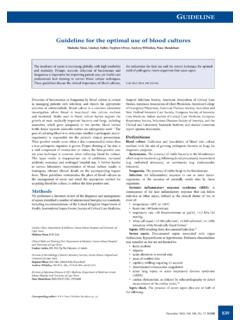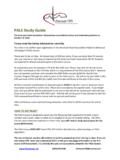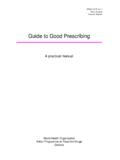Transcription of Setting up a Diagnostic Why go Molecular? …
1 SASCM WORKSHOP5/24/20141 Setting up a Diagnostic Molecular LaboratoryCornelis ClayAmpathMolecular Biology Laboratory24 May 2014 Why go Molecular? Impressive growth and developments in Molecular diagnostics last 15 years. Advantages of molecular diagnostics Quicker turn around time Improved sensitivities Increased accuracy Marked cost savings Industry driven by technologyA growing field Worldwide MDx market around $ billion! Steady growth being fuelled by: New technologies Innovations Expanded test applications Very broad Market : Not limited to one field of study genetics, infectious diseases, oncology, haematology and pharmacologyDesigning a lab Create a successful workflow for PCR Earlier years contamination of PCR rxn,s with amplification product from previous PCR was a potential problem To Combat contamination Three separate rooms Preparing the reaction Amplification Analysis of amplified products New instruments closed systems less contamination risk Facilities still need to be well designed No inflexible guidelines in molecular lab design primary emphasis is avoidance of contamination with each step of the workflowImportant components of Setting up a quality laboratory GCLP ensure that quality policies and standards are in place Standard operating procedures Assay techniques and processes standardised Validated methods Appropriate quality control Staff requirements training.
2 Competency Instrument and consumable Quality control Laboratory maintenance Appropriate facilitiesContamination Amplicon Aerosols Single most NB source of PCR product contamination associated with post PCR analysis Amplicons cannot be seen, felt, or detected before the contamination happens Target Template Contaminants Where target template itself is the source of contamination sample prep area and extraction areas. Aerosols generated during specimen prep Not following GLP during specimen preparation and extraction steps. Repeated analysis of similar samples Diagnostic labsSASCM WORKSHOP5/24/20142 PCR amplicon contamination control and removal of PCR ampliconsform the basis of contamination control : space and time separation of pre- and post-PCR activities use of physical aids use of ultraviolet (UV) light use of aliquoted PCR reagents, incorporation of numerous positive and negative or blank PCRs chemical and biochemical reactions Biochemical contamination preventionUracil-DNA-glycosylase (UDG) Enzyme effective at destroying PCR amplicons during pre-PCR step, dTTP is substituted with dUTP, and UDG is included in the reaction mix.
3 In the final product, there is now dU instead of dT in the DNA sequence exposed to UDG enzyme. If UDG comes across any U-containing DNA strands, the U s are cleaved, leaving the strand with gaps basic strands fall apart and cannot be amplified. Uracil-DNA-glycosylaseMolecular Lab Space and Design Limiting factor of PCR based technologies Contamination highly sensitive nature of PCR amplification Space and time separation of pre and post PCR activities Vital that correct workflow is followed minimise contamination. Major separations Pre amplification work Clean area Post PCR work Dirty area Environmental Considerations Air handling: air pressure UV radiation Dedicated lab coats Gloves available in all areas Non absorbent floors cleaned regularly and in a controlled manner LAB LAYOUT CLEAN AREA Sample preparation Reagent Room Loading RoomDIRTY AREA Amplification Room Detection Room Blot RoomONE WAY TRAFFICSASCM WORKSHOP5/24/20143 Clean area/rooms Specimen processing laboratory Specimens received, processed and stored.
4 Dedicated equipment normally found in Specimen processing laboratory Freezers and fridges for sample storage and extraction reagents storage. Biohazard hoods for initial sample preparation ( all specimens regarded as infectious) Centifuges, microfuges Dry heating blocks ( with dedicated thermometers) Dedicated pipettes (colour coded), filter tips, vortexes, timers Vacuum manifold (manual extractions), semi automated extraction platforms, fully automated extraction platforms Storage space for tubes, pipette tips and other Template laboratory reagent room PCR reagents stored, mastermix preparation for cDNA and amplification Positive air pressure Free of amplicon at all times!! Movement control / dedicated staff for each area on a rotational basis Dedicated equipment normally found in a no template room -20C Freezers, Fridge reagent storage Dedicated pipettes (Colour coded) filter tips Dedicated vortex Dedicated microfuge PCR workstations ( with UV light) Dedicated place to hang lab coats/ or disposable lab coats All consumables necessary to perform work in areaNo Template laboratoryNucleic acid loading area Extracted nucleic acid added to master mixes Dedicated equipment normally found in a loading area.
5 Freezer and Fridge ( positive controls and nucleic acid storage) PCR workstations Dedicated minifuge Dedicated pipettes (Colour coded) filter tips Dedicated vortexer Thermal cycler ( for cDNA synthesis only) Gloves Labcoats. Dirty areas Depending on the molecular detection platforms used this area can be divided into dedicated rooms /technology depending on available space Viral load platforms Real-time PCR platforms Thermal cyclers Line probe assays(ELISA based detection) GT Blot Sequencing platform Gel electrophoresis Nothing from these areas should move back to the clean area! Gloves and lab coats to be removed when leaving this area! Dedicated pipettes, fridges, freezers, vortex, area instrumentsGel electrophoresisSASCM WORKSHOP5/24/20144 Sample preparation/extraction To Isolate nucleic acid of interest Removes any potential inhibitors Concentrates the nucleic acid Increases the ability to detect very low concentrations of target nucleic acid.
6 Pre-extraction sample preparation: Problem area for developing fully automated systems due to sample source types Whole blood Serum Plasma Urine Stool Sputum Swabs nasal, cervical, rectal Fluids eye, amniotic, CSF Tissue BALN ucleic acid extraction Pre extraction steps: liquefaction, centrifugation, external lysis (lysis buffer, proteinase K, boiling). Manual extraction vacuum/spin - column based Semi automated Nuclisens Easymag Automated extraction More consistent results Eliminates operator variability manual methods Reduces hands on time Reduces transcription errors labelling multiple tubes Increase in productivity Higher throughputExtraction areaMagNApure 96 Common types of PCR used Conventional PCR Real-time PCR Different fluorescent detection chemistries SYBR Green I intercalating dye Dual-labeled fluorogenic oligonucleotide probes (TaqMan) Flourescence resonance energy transfer (FRET) probes Molecular Beacon probes Multiplex Real-time PCR Reverse transcription (RT) PCR (Real-time)
7 Controls used in PCR runs Positive control Contains target of interest and is known to work NB for qualitative assays identifies the amplification efficiency of the assay Negative control Extraction negative control -Water/PBS specimen that is extracted and loaded on PCR. Also controls for pipetting errors during loading of speimens as loading order is always specimens, pos control, neg control, blank. No template control (Blank) PCR reaction without presence of starting material Uses nuclease free water Indicates if PCR reagents are contaminated If positive investigate , clean all pipettes, work areas and replace reagents results cannot be used Internal control Monitor nucleic acid isolation procedure Indicates possible inhibition of PCR reaction.
8 Control is run in same tube as sample SASCM WORKSHOP5/24/20145 Platforms used Conventional PCR Thermal cycler, gel electrophoresis equipment, gel documentation system including UV transilluminator Real-time PCR/Multiplex PCR/RT-PCR Roche lightcycler, Rotorgene Smartcycler LC 480 Biorad CFX 96 Roche Cobas Ampliprep/Taqman Abbot M2000 SP/RTCepheid-SmartCycler Random access instrument Fluorophores FAM, Cy3/TET, Texas Red /ROX & Cy5 Detection Intercalating dyes (SYBR Green) TaqMan Molecular BeaconsRoche Cobas Ampliprep/TaqmanRoche LightcyclerUsing real-time PCR No opening of tubes = no ampliconsreleased Drastically reduced the risk of ampliconcontamination However: even these systems can have potential contamination issues: Lightcycler glass capillaries can brake Post Real-time containers not disposed of properly spills!
9 Test Menu Infectious disease Molecular Diagnostic Laboratory Virology Quantitative assays HIV, HBV, HCV, CMV, - automated platform EBV Real-time PCR Qualitative assays Real-time PCR Adenovirus, CMV, EBV, EV, Influenza, HBV, HCV, HHV6, HPV, HSV, Mumps virus, Parvo, VZV, RSV. JC/BK Multiplex assays Viral meningitis HSV-1/2, EV, Mumps, VZV, Parechovirus Respiratory Virus multiplex (16)Adeno, Inf A,B, RSV A,B, parainfluenza 1-4, HRV, EV, , MPV, HBoV, Corona (229E, NL63, OC43)Gastro viruses multiplex evaluation Adenovirus, Astro, Rotavirus, Noro GI, GII, SapoSASCM WORKSHOP5/24/20146 Bacteria, parasites, fungi Bordetella pertussis/parapertussis Brucella Clostridium difficile Chlamydophila pneumonia Clamydiae psittaci Legionella pneumophilae Mycoplasma pneumonia Toxoplasma gondii EPEC/EHEC Pneumocystis jiroveci Mycobacterium tuberculosis Malaria species identification Aspergillus spp RicketsiaReal time Multiplex.
10 Bacterial Respiratory bacteria 5 plex Bordetella pertussis/parapertussis, Legionellapneumophila, Chlamydophila pneumoniae, Mycoplasma pneumoniae STD 7 plex UU, UP, MG , MH , NG ,CT ,TV , IC. Carbapenemase 6 plex NDM-1, KPC, OXA, VIM, GES, IMP ICGenotyping/ Sequencing Hain TB drug resistance assay 1stline and 2ndline drug resistance. Mycobacterium spp. identification (CM/AS) Sequencing: HIV-1drug resistance testing Panfungal Panbacterial HCV genotypingRecent developments Significant advances microfluidics, micro-electronics and microfabrication Development of simplified molecular systems possibility of sample to result automation Facilitating implementation in labs that lack capacity or expertise to perform molecular testing potentially POC?








